BSc Business Management - Business Law: Analyzing UK Legal Context
VerifiedAdded on 2023/06/15
|10
|2983
|207
Report
AI Summary
This report provides an overview of the legal context for business organizations in the UK, focusing on key sources of law relevant to businesses. It begins by outlining the nature and management of companies, referencing relevant UK laws such as the National Minimum Wage Act, the Equity Act, and the Employees Rights Act. The report discusses business transaction management, vicarious liability, and business liability in negligence, highlighting the importance of skilled employees. It also details the roles, liabilities, and duties of company directors. Furthermore, the report explores various legal business structures available in the UK, including sole trading, general partnerships and partnerships, covering their definitions, formations, taxation, liabilities, dissolution processes, advantages, and disadvantages. The report concludes by providing recommendations for IOM Solutions, a sole trading company looking to expand, regarding the most appropriate legal business structure to adopt.
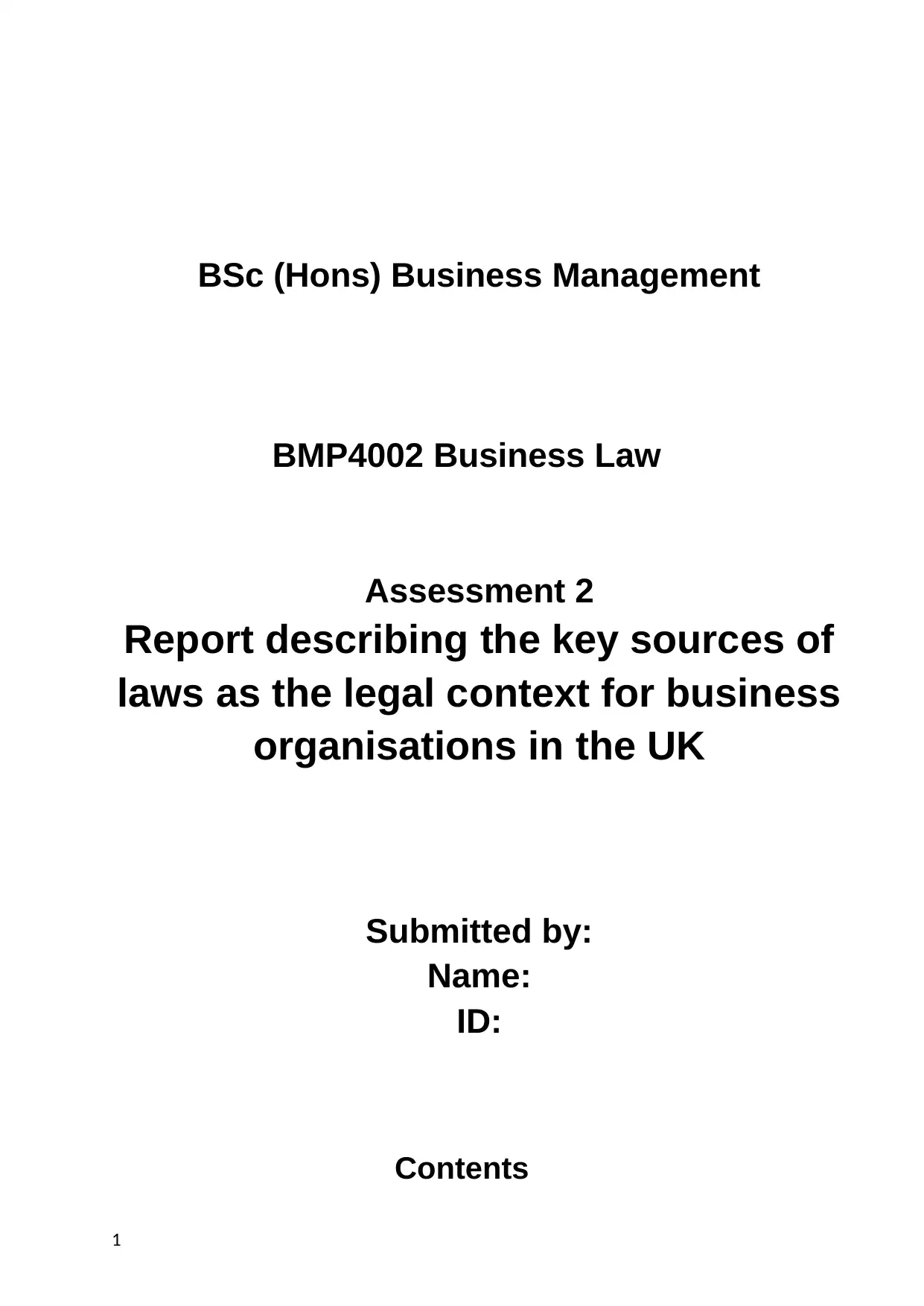
BSc (Hons) Business Management
BMP4002 Business Law
Assessment 2
Report describing the key sources of
laws as the legal context for business
organisations in the UK
Submitted by:
Name:
ID:
Contents
1
BMP4002 Business Law
Assessment 2
Report describing the key sources of
laws as the legal context for business
organisations in the UK
Submitted by:
Name:
ID:
Contents
1
Paraphrase This Document
Need a fresh take? Get an instant paraphrase of this document with our AI Paraphraser
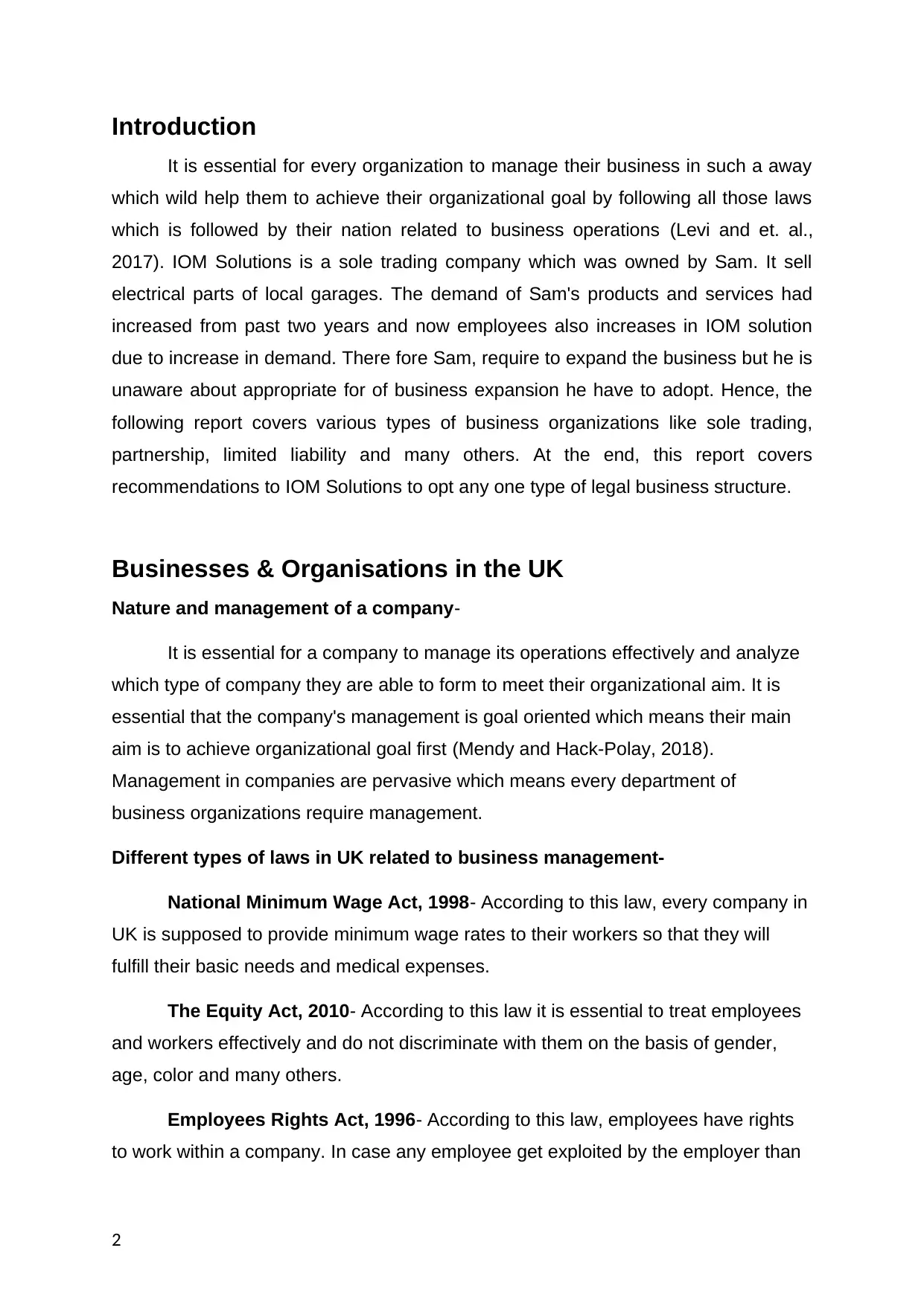
Introduction
It is essential for every organization to manage their business in such a away
which wild help them to achieve their organizational goal by following all those laws
which is followed by their nation related to business operations (Levi and et. al.,
2017). IOM Solutions is a sole trading company which was owned by Sam. It sell
electrical parts of local garages. The demand of Sam's products and services had
increased from past two years and now employees also increases in IOM solution
due to increase in demand. There fore Sam, require to expand the business but he is
unaware about appropriate for of business expansion he have to adopt. Hence, the
following report covers various types of business organizations like sole trading,
partnership, limited liability and many others. At the end, this report covers
recommendations to IOM Solutions to opt any one type of legal business structure.
Businesses & Organisations in the UK
Nature and management of a company-
It is essential for a company to manage its operations effectively and analyze
which type of company they are able to form to meet their organizational aim. It is
essential that the company's management is goal oriented which means their main
aim is to achieve organizational goal first (Mendy and Hack-Polay, 2018).
Management in companies are pervasive which means every department of
business organizations require management.
Different types of laws in UK related to business management-
National Minimum Wage Act, 1998- According to this law, every company in
UK is supposed to provide minimum wage rates to their workers so that they will
fulfill their basic needs and medical expenses.
The Equity Act, 2010- According to this law it is essential to treat employees
and workers effectively and do not discriminate with them on the basis of gender,
age, color and many others.
Employees Rights Act, 1996- According to this law, employees have rights
to work within a company. In case any employee get exploited by the employer than
2
It is essential for every organization to manage their business in such a away
which wild help them to achieve their organizational goal by following all those laws
which is followed by their nation related to business operations (Levi and et. al.,
2017). IOM Solutions is a sole trading company which was owned by Sam. It sell
electrical parts of local garages. The demand of Sam's products and services had
increased from past two years and now employees also increases in IOM solution
due to increase in demand. There fore Sam, require to expand the business but he is
unaware about appropriate for of business expansion he have to adopt. Hence, the
following report covers various types of business organizations like sole trading,
partnership, limited liability and many others. At the end, this report covers
recommendations to IOM Solutions to opt any one type of legal business structure.
Businesses & Organisations in the UK
Nature and management of a company-
It is essential for a company to manage its operations effectively and analyze
which type of company they are able to form to meet their organizational aim. It is
essential that the company's management is goal oriented which means their main
aim is to achieve organizational goal first (Mendy and Hack-Polay, 2018).
Management in companies are pervasive which means every department of
business organizations require management.
Different types of laws in UK related to business management-
National Minimum Wage Act, 1998- According to this law, every company in
UK is supposed to provide minimum wage rates to their workers so that they will
fulfill their basic needs and medical expenses.
The Equity Act, 2010- According to this law it is essential to treat employees
and workers effectively and do not discriminate with them on the basis of gender,
age, color and many others.
Employees Rights Act, 1996- According to this law, employees have rights
to work within a company. In case any employee get exploited by the employer than
2
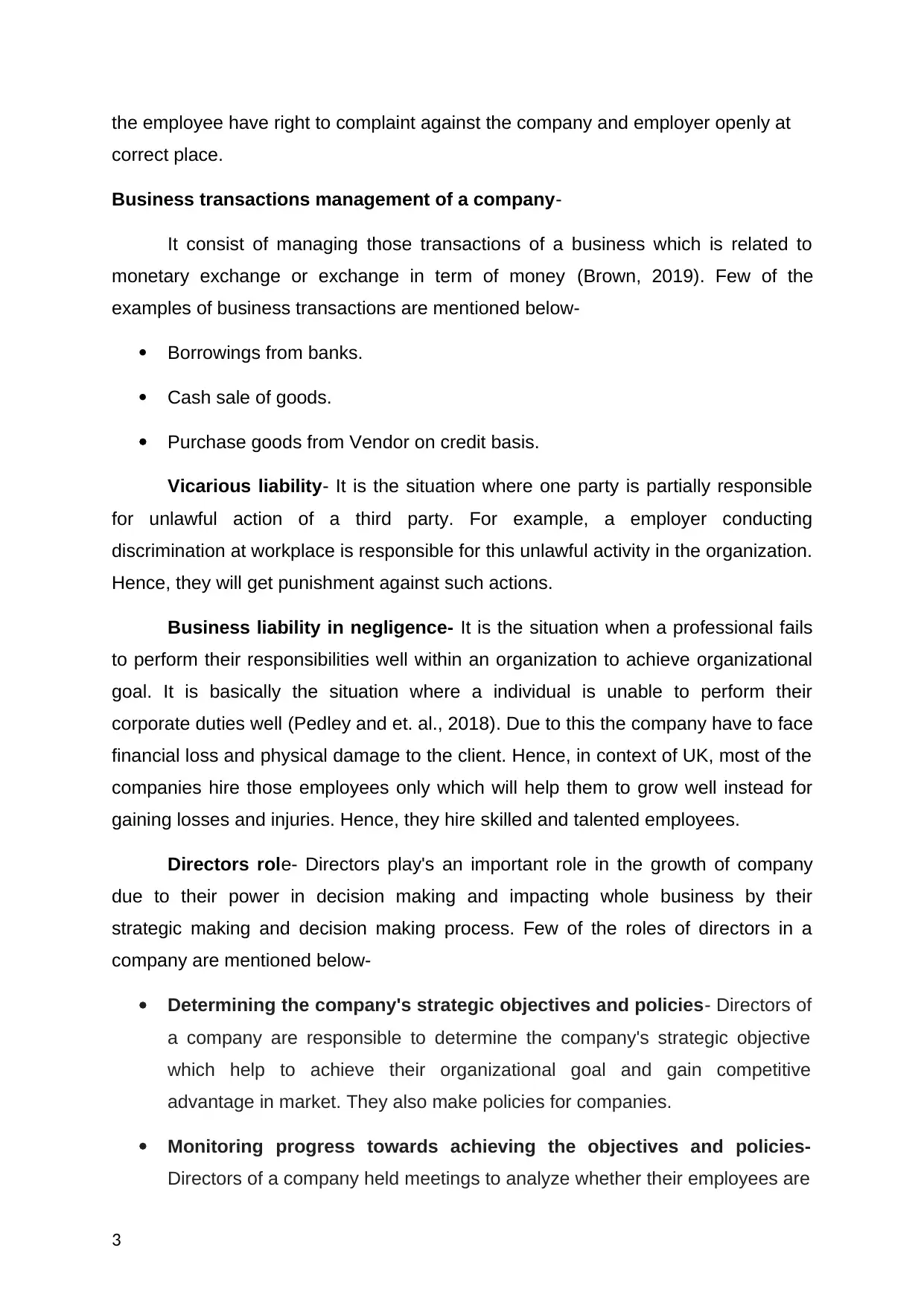
the employee have right to complaint against the company and employer openly at
correct place.
Business transactions management of a company-
It consist of managing those transactions of a business which is related to
monetary exchange or exchange in term of money (Brown, 2019). Few of the
examples of business transactions are mentioned below-
Borrowings from banks.
Cash sale of goods.
Purchase goods from Vendor on credit basis.
Vicarious liability- It is the situation where one party is partially responsible
for unlawful action of a third party. For example, a employer conducting
discrimination at workplace is responsible for this unlawful activity in the organization.
Hence, they will get punishment against such actions.
Business liability in negligence- It is the situation when a professional fails
to perform their responsibilities well within an organization to achieve organizational
goal. It is basically the situation where a individual is unable to perform their
corporate duties well (Pedley and et. al., 2018). Due to this the company have to face
financial loss and physical damage to the client. Hence, in context of UK, most of the
companies hire those employees only which will help them to grow well instead for
gaining losses and injuries. Hence, they hire skilled and talented employees.
Directors role- Directors play's an important role in the growth of company
due to their power in decision making and impacting whole business by their
strategic making and decision making process. Few of the roles of directors in a
company are mentioned below-
Determining the company's strategic objectives and policies- Directors of
a company are responsible to determine the company's strategic objective
which help to achieve their organizational goal and gain competitive
advantage in market. They also make policies for companies.
Monitoring progress towards achieving the objectives and policies-
Directors of a company held meetings to analyze whether their employees are
3
correct place.
Business transactions management of a company-
It consist of managing those transactions of a business which is related to
monetary exchange or exchange in term of money (Brown, 2019). Few of the
examples of business transactions are mentioned below-
Borrowings from banks.
Cash sale of goods.
Purchase goods from Vendor on credit basis.
Vicarious liability- It is the situation where one party is partially responsible
for unlawful action of a third party. For example, a employer conducting
discrimination at workplace is responsible for this unlawful activity in the organization.
Hence, they will get punishment against such actions.
Business liability in negligence- It is the situation when a professional fails
to perform their responsibilities well within an organization to achieve organizational
goal. It is basically the situation where a individual is unable to perform their
corporate duties well (Pedley and et. al., 2018). Due to this the company have to face
financial loss and physical damage to the client. Hence, in context of UK, most of the
companies hire those employees only which will help them to grow well instead for
gaining losses and injuries. Hence, they hire skilled and talented employees.
Directors role- Directors play's an important role in the growth of company
due to their power in decision making and impacting whole business by their
strategic making and decision making process. Few of the roles of directors in a
company are mentioned below-
Determining the company's strategic objectives and policies- Directors of
a company are responsible to determine the company's strategic objective
which help to achieve their organizational goal and gain competitive
advantage in market. They also make policies for companies.
Monitoring progress towards achieving the objectives and policies-
Directors of a company held meetings to analyze whether their employees are
3
⊘ This is a preview!⊘
Do you want full access?
Subscribe today to unlock all pages.

Trusted by 1+ million students worldwide
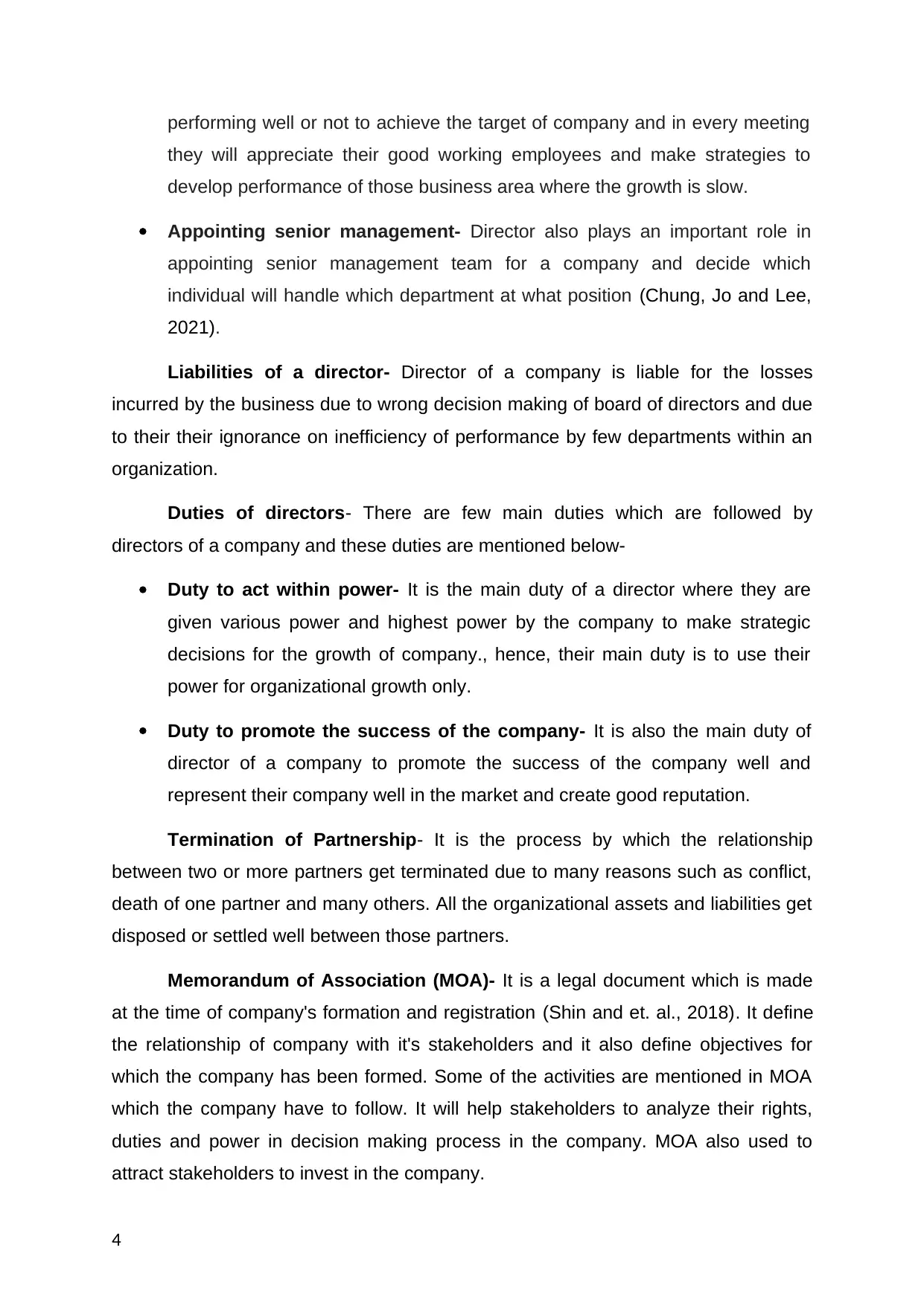
performing well or not to achieve the target of company and in every meeting
they will appreciate their good working employees and make strategies to
develop performance of those business area where the growth is slow.
Appointing senior management- Director also plays an important role in
appointing senior management team for a company and decide which
individual will handle which department at what position (Chung, Jo and Lee,
2021).
Liabilities of a director- Director of a company is liable for the losses
incurred by the business due to wrong decision making of board of directors and due
to their their ignorance on inefficiency of performance by few departments within an
organization.
Duties of directors- There are few main duties which are followed by
directors of a company and these duties are mentioned below-
Duty to act within power- It is the main duty of a director where they are
given various power and highest power by the company to make strategic
decisions for the growth of company., hence, their main duty is to use their
power for organizational growth only.
Duty to promote the success of the company- It is also the main duty of
director of a company to promote the success of the company well and
represent their company well in the market and create good reputation.
Termination of Partnership- It is the process by which the relationship
between two or more partners get terminated due to many reasons such as conflict,
death of one partner and many others. All the organizational assets and liabilities get
disposed or settled well between those partners.
Memorandum of Association (MOA)- It is a legal document which is made
at the time of company's formation and registration (Shin and et. al., 2018). It define
the relationship of company with it's stakeholders and it also define objectives for
which the company has been formed. Some of the activities are mentioned in MOA
which the company have to follow. It will help stakeholders to analyze their rights,
duties and power in decision making process in the company. MOA also used to
attract stakeholders to invest in the company.
4
they will appreciate their good working employees and make strategies to
develop performance of those business area where the growth is slow.
Appointing senior management- Director also plays an important role in
appointing senior management team for a company and decide which
individual will handle which department at what position (Chung, Jo and Lee,
2021).
Liabilities of a director- Director of a company is liable for the losses
incurred by the business due to wrong decision making of board of directors and due
to their their ignorance on inefficiency of performance by few departments within an
organization.
Duties of directors- There are few main duties which are followed by
directors of a company and these duties are mentioned below-
Duty to act within power- It is the main duty of a director where they are
given various power and highest power by the company to make strategic
decisions for the growth of company., hence, their main duty is to use their
power for organizational growth only.
Duty to promote the success of the company- It is also the main duty of
director of a company to promote the success of the company well and
represent their company well in the market and create good reputation.
Termination of Partnership- It is the process by which the relationship
between two or more partners get terminated due to many reasons such as conflict,
death of one partner and many others. All the organizational assets and liabilities get
disposed or settled well between those partners.
Memorandum of Association (MOA)- It is a legal document which is made
at the time of company's formation and registration (Shin and et. al., 2018). It define
the relationship of company with it's stakeholders and it also define objectives for
which the company has been formed. Some of the activities are mentioned in MOA
which the company have to follow. It will help stakeholders to analyze their rights,
duties and power in decision making process in the company. MOA also used to
attract stakeholders to invest in the company.
4
Paraphrase This Document
Need a fresh take? Get an instant paraphrase of this document with our AI Paraphraser
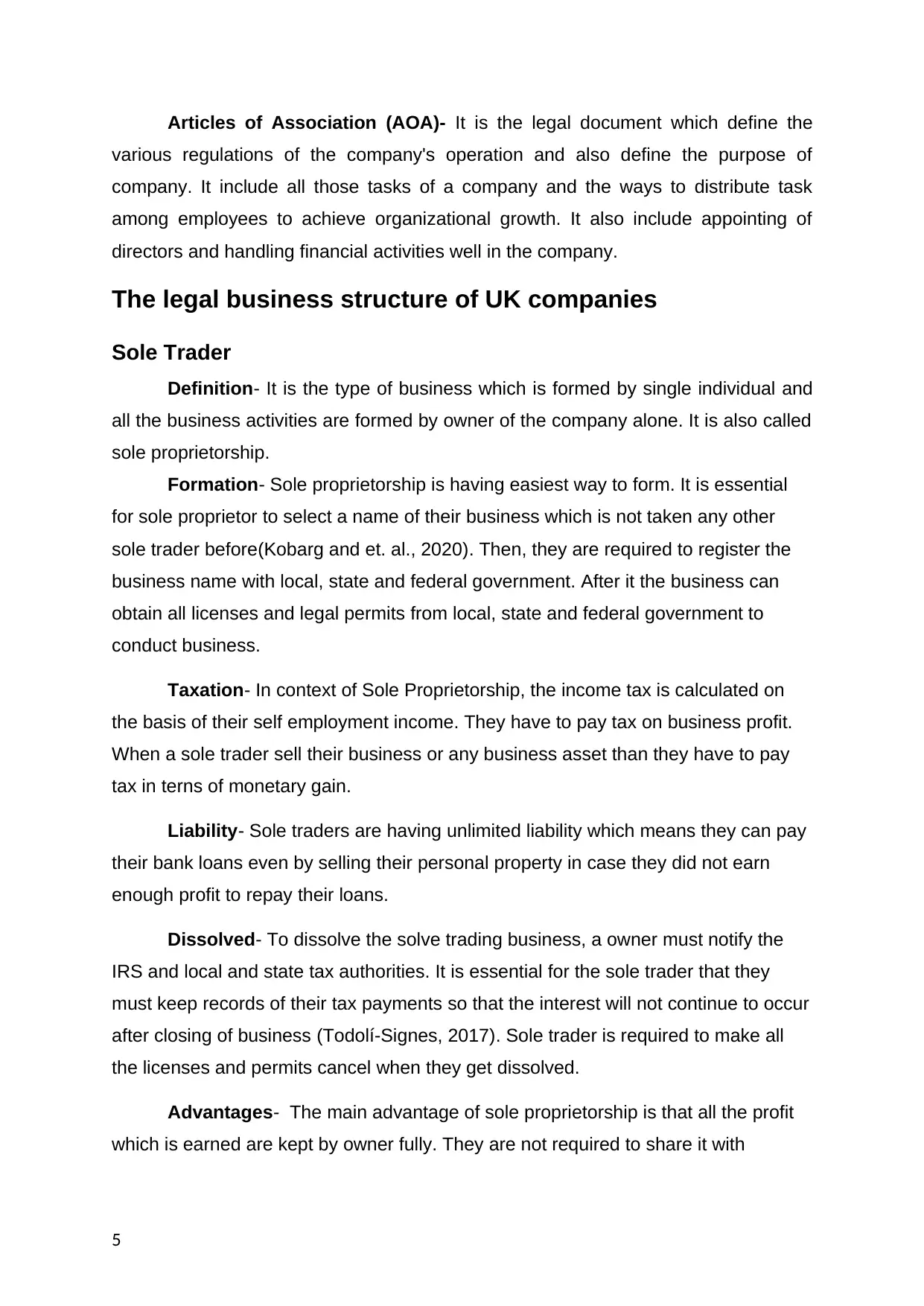
Articles of Association (AOA)- It is the legal document which define the
various regulations of the company's operation and also define the purpose of
company. It include all those tasks of a company and the ways to distribute task
among employees to achieve organizational growth. It also include appointing of
directors and handling financial activities well in the company.
The legal business structure of UK companies
Sole Trader
Definition- It is the type of business which is formed by single individual and
all the business activities are formed by owner of the company alone. It is also called
sole proprietorship.
Formation- Sole proprietorship is having easiest way to form. It is essential
for sole proprietor to select a name of their business which is not taken any other
sole trader before(Kobarg and et. al., 2020). Then, they are required to register the
business name with local, state and federal government. After it the business can
obtain all licenses and legal permits from local, state and federal government to
conduct business.
Taxation- In context of Sole Proprietorship, the income tax is calculated on
the basis of their self employment income. They have to pay tax on business profit.
When a sole trader sell their business or any business asset than they have to pay
tax in terns of monetary gain.
Liability- Sole traders are having unlimited liability which means they can pay
their bank loans even by selling their personal property in case they did not earn
enough profit to repay their loans.
Dissolved- To dissolve the solve trading business, a owner must notify the
IRS and local and state tax authorities. It is essential for the sole trader that they
must keep records of their tax payments so that the interest will not continue to occur
after closing of business (Todolí-Signes, 2017). Sole trader is required to make all
the licenses and permits cancel when they get dissolved.
Advantages- The main advantage of sole proprietorship is that all the profit
which is earned are kept by owner fully. They are not required to share it with
5
various regulations of the company's operation and also define the purpose of
company. It include all those tasks of a company and the ways to distribute task
among employees to achieve organizational growth. It also include appointing of
directors and handling financial activities well in the company.
The legal business structure of UK companies
Sole Trader
Definition- It is the type of business which is formed by single individual and
all the business activities are formed by owner of the company alone. It is also called
sole proprietorship.
Formation- Sole proprietorship is having easiest way to form. It is essential
for sole proprietor to select a name of their business which is not taken any other
sole trader before(Kobarg and et. al., 2020). Then, they are required to register the
business name with local, state and federal government. After it the business can
obtain all licenses and legal permits from local, state and federal government to
conduct business.
Taxation- In context of Sole Proprietorship, the income tax is calculated on
the basis of their self employment income. They have to pay tax on business profit.
When a sole trader sell their business or any business asset than they have to pay
tax in terns of monetary gain.
Liability- Sole traders are having unlimited liability which means they can pay
their bank loans even by selling their personal property in case they did not earn
enough profit to repay their loans.
Dissolved- To dissolve the solve trading business, a owner must notify the
IRS and local and state tax authorities. It is essential for the sole trader that they
must keep records of their tax payments so that the interest will not continue to occur
after closing of business (Todolí-Signes, 2017). Sole trader is required to make all
the licenses and permits cancel when they get dissolved.
Advantages- The main advantage of sole proprietorship is that all the profit
which is earned are kept by owner fully. They are not required to share it with
5
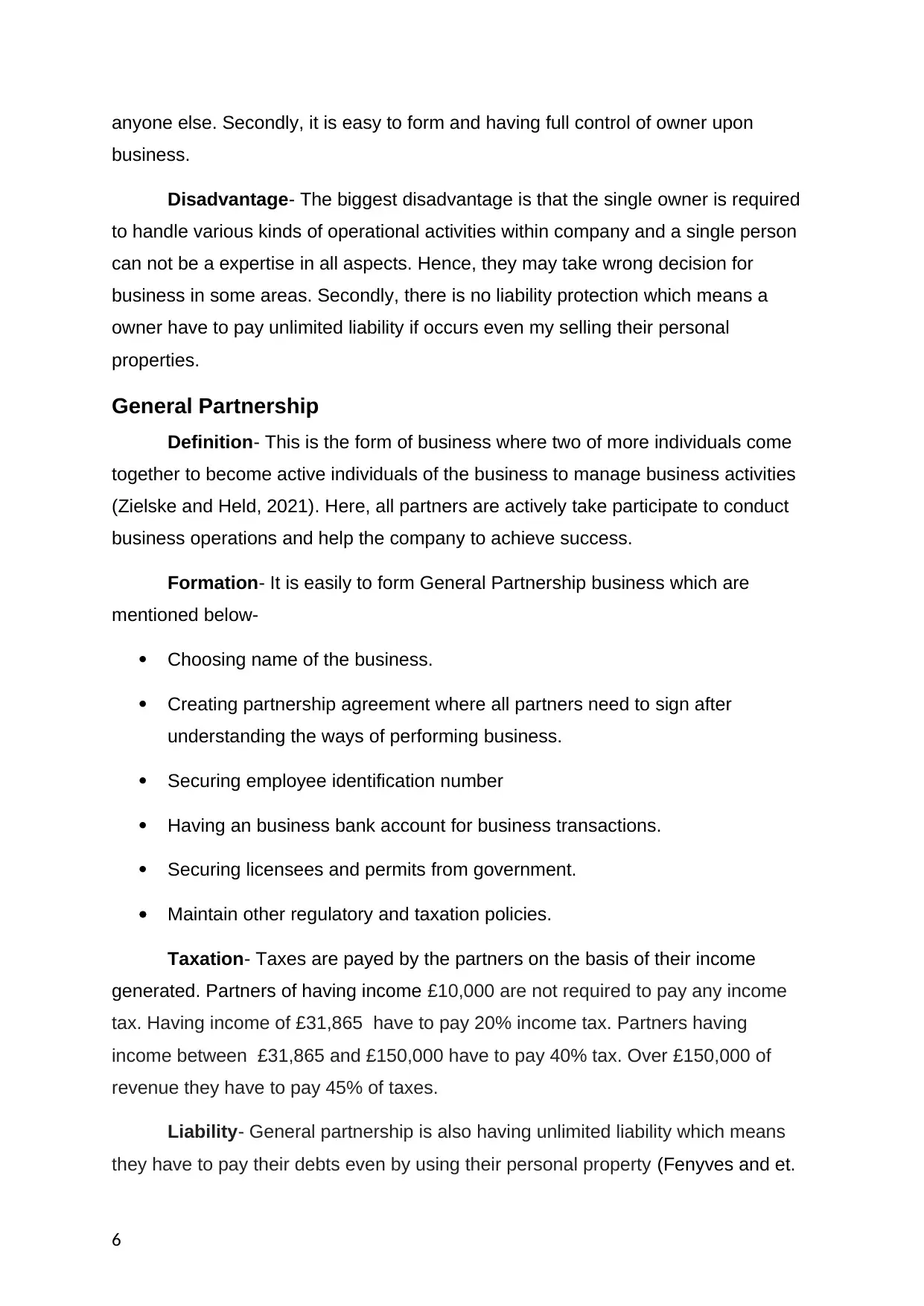
anyone else. Secondly, it is easy to form and having full control of owner upon
business.
Disadvantage- The biggest disadvantage is that the single owner is required
to handle various kinds of operational activities within company and a single person
can not be a expertise in all aspects. Hence, they may take wrong decision for
business in some areas. Secondly, there is no liability protection which means a
owner have to pay unlimited liability if occurs even my selling their personal
properties.
General Partnership
Definition- This is the form of business where two of more individuals come
together to become active individuals of the business to manage business activities
(Zielske and Held, 2021). Here, all partners are actively take participate to conduct
business operations and help the company to achieve success.
Formation- It is easily to form General Partnership business which are
mentioned below-
Choosing name of the business.
Creating partnership agreement where all partners need to sign after
understanding the ways of performing business.
Securing employee identification number
Having an business bank account for business transactions.
Securing licensees and permits from government.
Maintain other regulatory and taxation policies.
Taxation- Taxes are payed by the partners on the basis of their income
generated. Partners of having income £10,000 are not required to pay any income
tax. Having income of £31,865 have to pay 20% income tax. Partners having
income between £31,865 and £150,000 have to pay 40% tax. Over £150,000 of
revenue they have to pay 45% of taxes.
Liability- General partnership is also having unlimited liability which means
they have to pay their debts even by using their personal property (Fenyves and et.
6
business.
Disadvantage- The biggest disadvantage is that the single owner is required
to handle various kinds of operational activities within company and a single person
can not be a expertise in all aspects. Hence, they may take wrong decision for
business in some areas. Secondly, there is no liability protection which means a
owner have to pay unlimited liability if occurs even my selling their personal
properties.
General Partnership
Definition- This is the form of business where two of more individuals come
together to become active individuals of the business to manage business activities
(Zielske and Held, 2021). Here, all partners are actively take participate to conduct
business operations and help the company to achieve success.
Formation- It is easily to form General Partnership business which are
mentioned below-
Choosing name of the business.
Creating partnership agreement where all partners need to sign after
understanding the ways of performing business.
Securing employee identification number
Having an business bank account for business transactions.
Securing licensees and permits from government.
Maintain other regulatory and taxation policies.
Taxation- Taxes are payed by the partners on the basis of their income
generated. Partners of having income £10,000 are not required to pay any income
tax. Having income of £31,865 have to pay 20% income tax. Partners having
income between £31,865 and £150,000 have to pay 40% tax. Over £150,000 of
revenue they have to pay 45% of taxes.
Liability- General partnership is also having unlimited liability which means
they have to pay their debts even by using their personal property (Fenyves and et.
6
⊘ This is a preview!⊘
Do you want full access?
Subscribe today to unlock all pages.

Trusted by 1+ million students worldwide
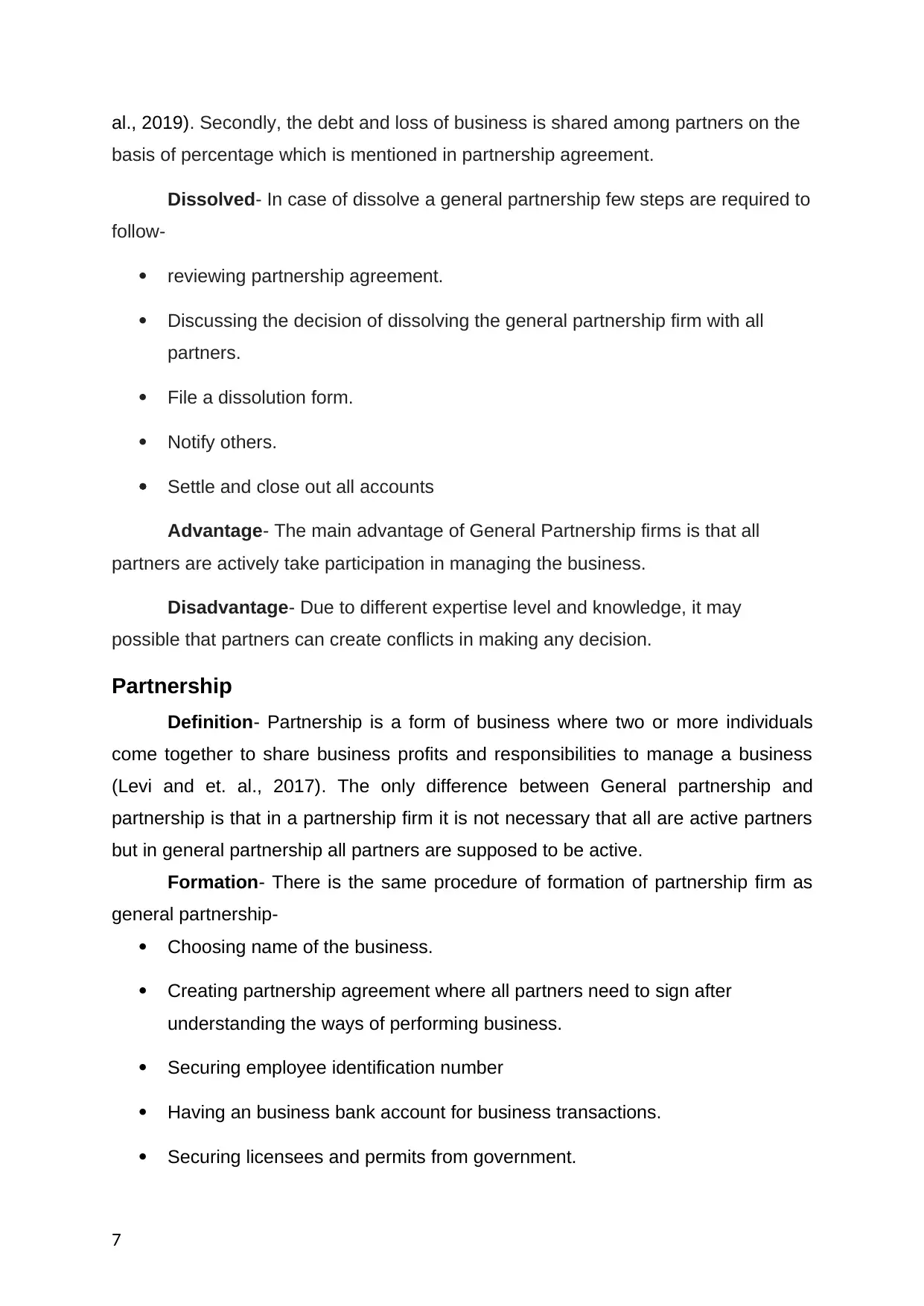
al., 2019). Secondly, the debt and loss of business is shared among partners on the
basis of percentage which is mentioned in partnership agreement.
Dissolved- In case of dissolve a general partnership few steps are required to
follow-
reviewing partnership agreement.
Discussing the decision of dissolving the general partnership firm with all
partners.
File a dissolution form.
Notify others.
Settle and close out all accounts
Advantage- The main advantage of General Partnership firms is that all
partners are actively take participation in managing the business.
Disadvantage- Due to different expertise level and knowledge, it may
possible that partners can create conflicts in making any decision.
Partnership
Definition- Partnership is a form of business where two or more individuals
come together to share business profits and responsibilities to manage a business
(Levi and et. al., 2017). The only difference between General partnership and
partnership is that in a partnership firm it is not necessary that all are active partners
but in general partnership all partners are supposed to be active.
Formation- There is the same procedure of formation of partnership firm as
general partnership-
Choosing name of the business.
Creating partnership agreement where all partners need to sign after
understanding the ways of performing business.
Securing employee identification number
Having an business bank account for business transactions.
Securing licensees and permits from government.
7
basis of percentage which is mentioned in partnership agreement.
Dissolved- In case of dissolve a general partnership few steps are required to
follow-
reviewing partnership agreement.
Discussing the decision of dissolving the general partnership firm with all
partners.
File a dissolution form.
Notify others.
Settle and close out all accounts
Advantage- The main advantage of General Partnership firms is that all
partners are actively take participation in managing the business.
Disadvantage- Due to different expertise level and knowledge, it may
possible that partners can create conflicts in making any decision.
Partnership
Definition- Partnership is a form of business where two or more individuals
come together to share business profits and responsibilities to manage a business
(Levi and et. al., 2017). The only difference between General partnership and
partnership is that in a partnership firm it is not necessary that all are active partners
but in general partnership all partners are supposed to be active.
Formation- There is the same procedure of formation of partnership firm as
general partnership-
Choosing name of the business.
Creating partnership agreement where all partners need to sign after
understanding the ways of performing business.
Securing employee identification number
Having an business bank account for business transactions.
Securing licensees and permits from government.
7
Paraphrase This Document
Need a fresh take? Get an instant paraphrase of this document with our AI Paraphraser
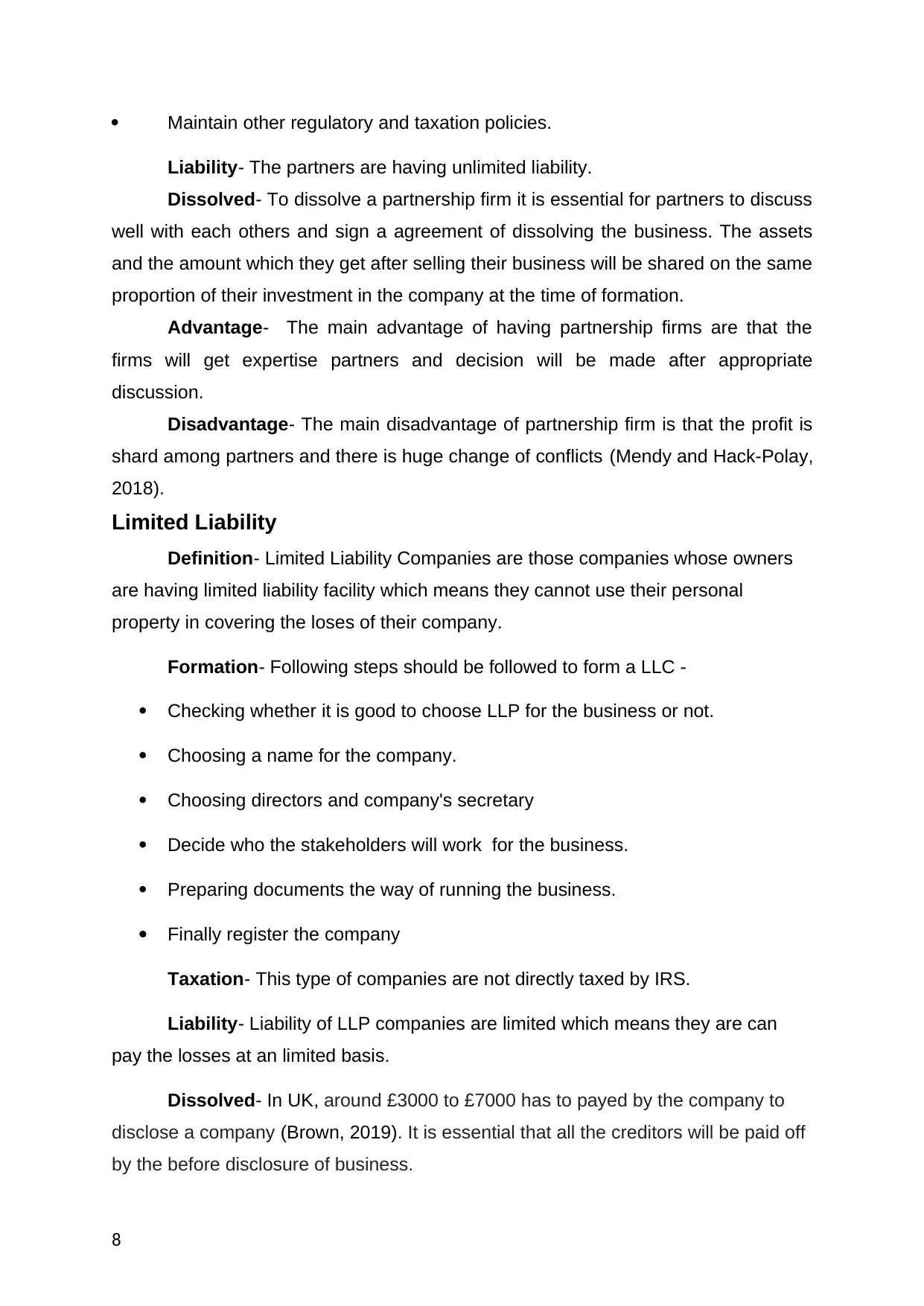
Maintain other regulatory and taxation policies.
Liability- The partners are having unlimited liability.
Dissolved- To dissolve a partnership firm it is essential for partners to discuss
well with each others and sign a agreement of dissolving the business. The assets
and the amount which they get after selling their business will be shared on the same
proportion of their investment in the company at the time of formation.
Advantage- The main advantage of having partnership firms are that the
firms will get expertise partners and decision will be made after appropriate
discussion.
Disadvantage- The main disadvantage of partnership firm is that the profit is
shard among partners and there is huge change of conflicts (Mendy and Hack-Polay,
2018).
Limited Liability
Definition- Limited Liability Companies are those companies whose owners
are having limited liability facility which means they cannot use their personal
property in covering the loses of their company.
Formation- Following steps should be followed to form a LLC -
Checking whether it is good to choose LLP for the business or not.
Choosing a name for the company.
Choosing directors and company's secretary
Decide who the stakeholders will work for the business.
Preparing documents the way of running the business.
Finally register the company
Taxation- This type of companies are not directly taxed by IRS.
Liability- Liability of LLP companies are limited which means they are can
pay the losses at an limited basis.
Dissolved- In UK, around £3000 to £7000 has to payed by the company to
disclose a company (Brown, 2019). It is essential that all the creditors will be paid off
by the before disclosure of business.
8
Liability- The partners are having unlimited liability.
Dissolved- To dissolve a partnership firm it is essential for partners to discuss
well with each others and sign a agreement of dissolving the business. The assets
and the amount which they get after selling their business will be shared on the same
proportion of their investment in the company at the time of formation.
Advantage- The main advantage of having partnership firms are that the
firms will get expertise partners and decision will be made after appropriate
discussion.
Disadvantage- The main disadvantage of partnership firm is that the profit is
shard among partners and there is huge change of conflicts (Mendy and Hack-Polay,
2018).
Limited Liability
Definition- Limited Liability Companies are those companies whose owners
are having limited liability facility which means they cannot use their personal
property in covering the loses of their company.
Formation- Following steps should be followed to form a LLC -
Checking whether it is good to choose LLP for the business or not.
Choosing a name for the company.
Choosing directors and company's secretary
Decide who the stakeholders will work for the business.
Preparing documents the way of running the business.
Finally register the company
Taxation- This type of companies are not directly taxed by IRS.
Liability- Liability of LLP companies are limited which means they are can
pay the losses at an limited basis.
Dissolved- In UK, around £3000 to £7000 has to payed by the company to
disclose a company (Brown, 2019). It is essential that all the creditors will be paid off
by the before disclosure of business.
8
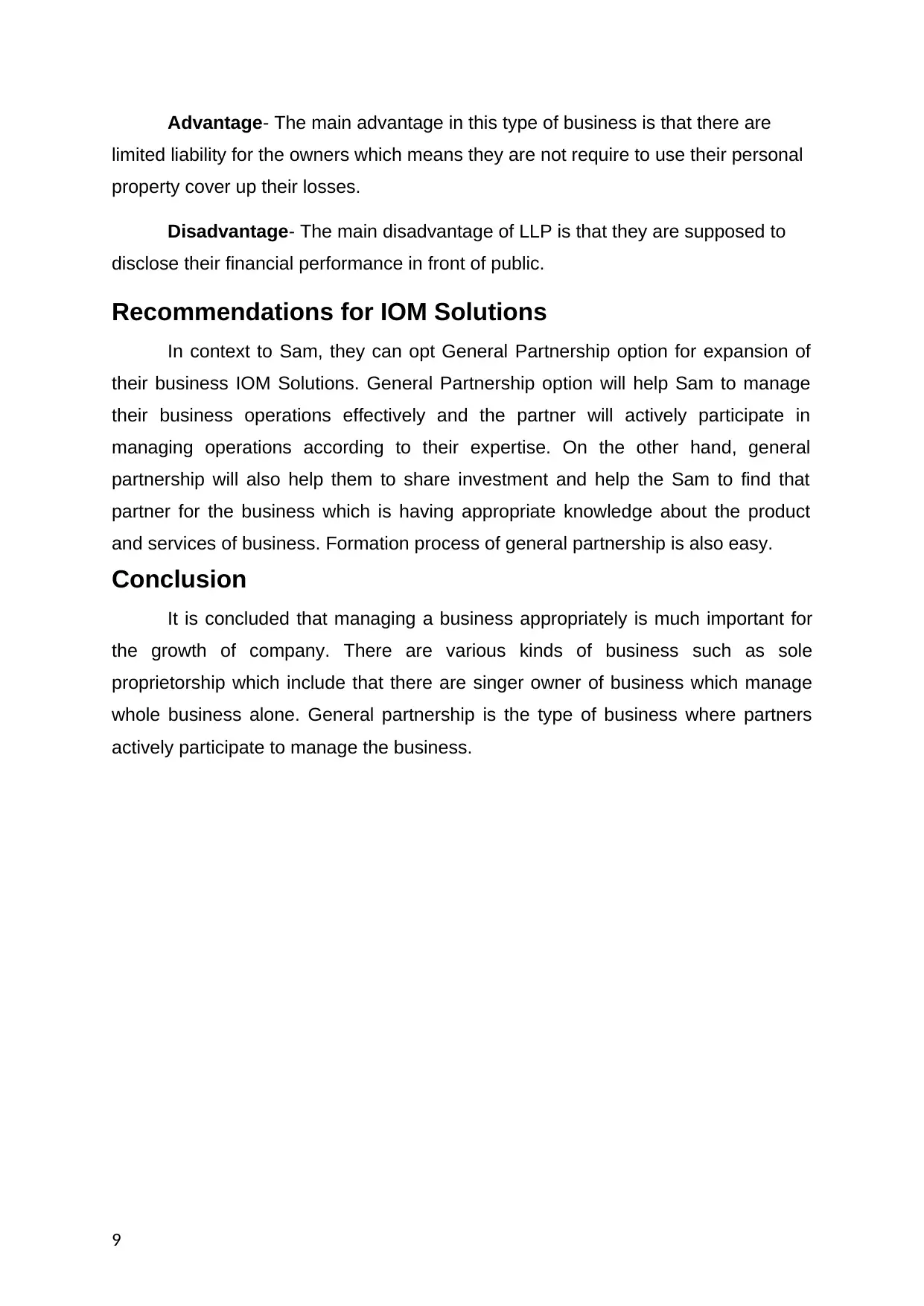
Advantage- The main advantage in this type of business is that there are
limited liability for the owners which means they are not require to use their personal
property cover up their losses.
Disadvantage- The main disadvantage of LLP is that they are supposed to
disclose their financial performance in front of public.
Recommendations for IOM Solutions
In context to Sam, they can opt General Partnership option for expansion of
their business IOM Solutions. General Partnership option will help Sam to manage
their business operations effectively and the partner will actively participate in
managing operations according to their expertise. On the other hand, general
partnership will also help them to share investment and help the Sam to find that
partner for the business which is having appropriate knowledge about the product
and services of business. Formation process of general partnership is also easy.
Conclusion
It is concluded that managing a business appropriately is much important for
the growth of company. There are various kinds of business such as sole
proprietorship which include that there are singer owner of business which manage
whole business alone. General partnership is the type of business where partners
actively participate to manage the business.
9
limited liability for the owners which means they are not require to use their personal
property cover up their losses.
Disadvantage- The main disadvantage of LLP is that they are supposed to
disclose their financial performance in front of public.
Recommendations for IOM Solutions
In context to Sam, they can opt General Partnership option for expansion of
their business IOM Solutions. General Partnership option will help Sam to manage
their business operations effectively and the partner will actively participate in
managing operations according to their expertise. On the other hand, general
partnership will also help them to share investment and help the Sam to find that
partner for the business which is having appropriate knowledge about the product
and services of business. Formation process of general partnership is also easy.
Conclusion
It is concluded that managing a business appropriately is much important for
the growth of company. There are various kinds of business such as sole
proprietorship which include that there are singer owner of business which manage
whole business alone. General partnership is the type of business where partners
actively participate to manage the business.
9
⊘ This is a preview!⊘
Do you want full access?
Subscribe today to unlock all pages.

Trusted by 1+ million students worldwide
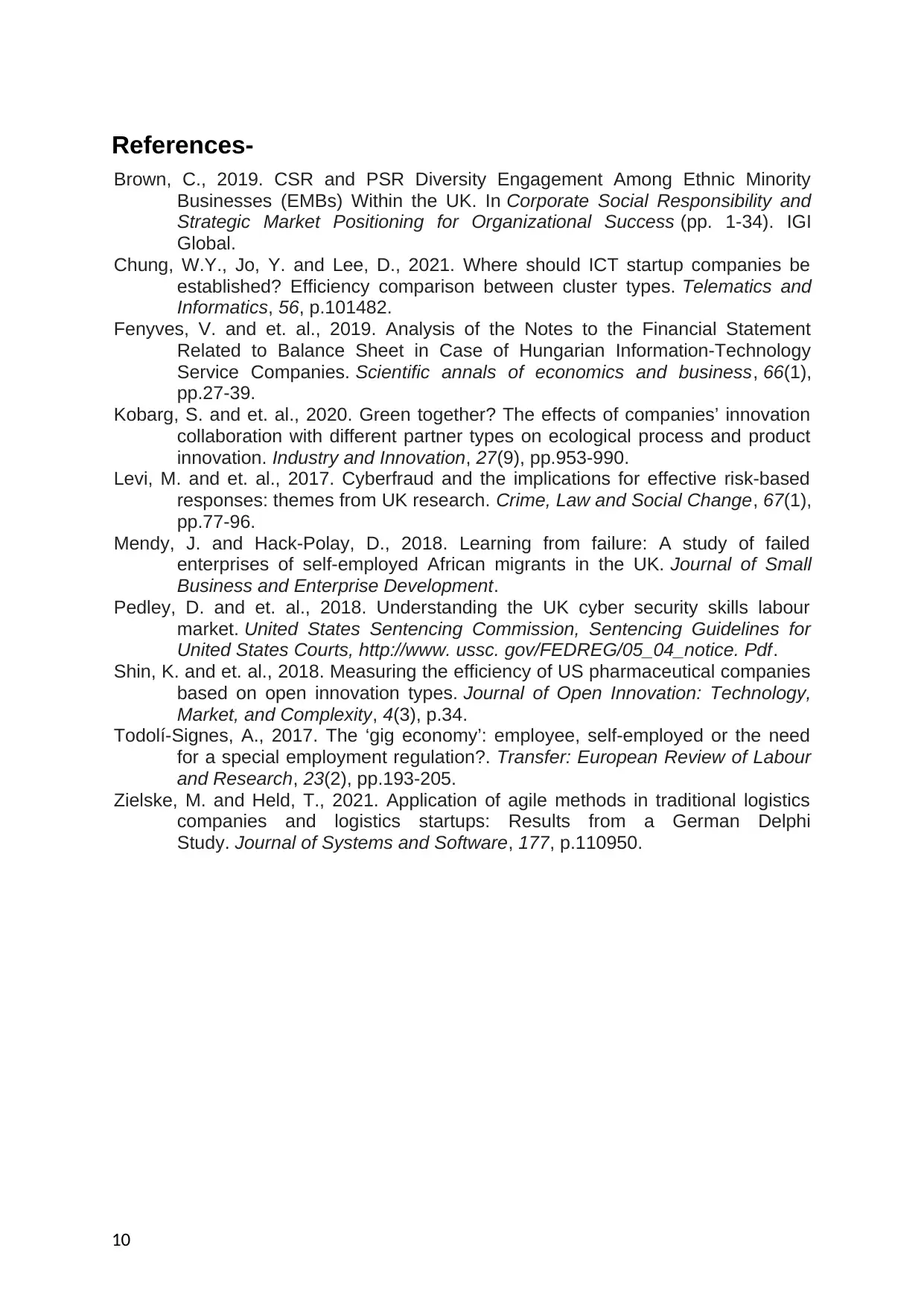
References-
Brown, C., 2019. CSR and PSR Diversity Engagement Among Ethnic Minority
Businesses (EMBs) Within the UK. In Corporate Social Responsibility and
Strategic Market Positioning for Organizational Success (pp. 1-34). IGI
Global.
Chung, W.Y., Jo, Y. and Lee, D., 2021. Where should ICT startup companies be
established? Efficiency comparison between cluster types. Telematics and
Informatics, 56, p.101482.
Fenyves, V. and et. al., 2019. Analysis of the Notes to the Financial Statement
Related to Balance Sheet in Case of Hungarian Information-Technology
Service Companies. Scientific annals of economics and business, 66(1),
pp.27-39.
Kobarg, S. and et. al., 2020. Green together? The effects of companies’ innovation
collaboration with different partner types on ecological process and product
innovation. Industry and Innovation, 27(9), pp.953-990.
Levi, M. and et. al., 2017. Cyberfraud and the implications for effective risk-based
responses: themes from UK research. Crime, Law and Social Change, 67(1),
pp.77-96.
Mendy, J. and Hack-Polay, D., 2018. Learning from failure: A study of failed
enterprises of self-employed African migrants in the UK. Journal of Small
Business and Enterprise Development.
Pedley, D. and et. al., 2018. Understanding the UK cyber security skills labour
market. United States Sentencing Commission, Sentencing Guidelines for
United States Courts, http://www. ussc. gov/FEDREG/05_04_notice. Pdf.
Shin, K. and et. al., 2018. Measuring the efficiency of US pharmaceutical companies
based on open innovation types. Journal of Open Innovation: Technology,
Market, and Complexity, 4(3), p.34.
Todolí-Signes, A., 2017. The ‘gig economy’: employee, self-employed or the need
for a special employment regulation?. Transfer: European Review of Labour
and Research, 23(2), pp.193-205.
Zielske, M. and Held, T., 2021. Application of agile methods in traditional logistics
companies and logistics startups: Results from a German Delphi
Study. Journal of Systems and Software, 177, p.110950.
10
Brown, C., 2019. CSR and PSR Diversity Engagement Among Ethnic Minority
Businesses (EMBs) Within the UK. In Corporate Social Responsibility and
Strategic Market Positioning for Organizational Success (pp. 1-34). IGI
Global.
Chung, W.Y., Jo, Y. and Lee, D., 2021. Where should ICT startup companies be
established? Efficiency comparison between cluster types. Telematics and
Informatics, 56, p.101482.
Fenyves, V. and et. al., 2019. Analysis of the Notes to the Financial Statement
Related to Balance Sheet in Case of Hungarian Information-Technology
Service Companies. Scientific annals of economics and business, 66(1),
pp.27-39.
Kobarg, S. and et. al., 2020. Green together? The effects of companies’ innovation
collaboration with different partner types on ecological process and product
innovation. Industry and Innovation, 27(9), pp.953-990.
Levi, M. and et. al., 2017. Cyberfraud and the implications for effective risk-based
responses: themes from UK research. Crime, Law and Social Change, 67(1),
pp.77-96.
Mendy, J. and Hack-Polay, D., 2018. Learning from failure: A study of failed
enterprises of self-employed African migrants in the UK. Journal of Small
Business and Enterprise Development.
Pedley, D. and et. al., 2018. Understanding the UK cyber security skills labour
market. United States Sentencing Commission, Sentencing Guidelines for
United States Courts, http://www. ussc. gov/FEDREG/05_04_notice. Pdf.
Shin, K. and et. al., 2018. Measuring the efficiency of US pharmaceutical companies
based on open innovation types. Journal of Open Innovation: Technology,
Market, and Complexity, 4(3), p.34.
Todolí-Signes, A., 2017. The ‘gig economy’: employee, self-employed or the need
for a special employment regulation?. Transfer: European Review of Labour
and Research, 23(2), pp.193-205.
Zielske, M. and Held, T., 2021. Application of agile methods in traditional logistics
companies and logistics startups: Results from a German Delphi
Study. Journal of Systems and Software, 177, p.110950.
10
1 out of 10
Related Documents
Your All-in-One AI-Powered Toolkit for Academic Success.
+13062052269
info@desklib.com
Available 24*7 on WhatsApp / Email
![[object Object]](/_next/static/media/star-bottom.7253800d.svg)
Unlock your academic potential
Copyright © 2020–2025 A2Z Services. All Rights Reserved. Developed and managed by ZUCOL.
